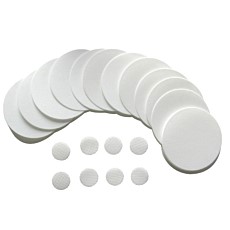
For consumers using disk, syringe, and capsule filters it is a common FAQ: How long will my filter last? Or, to put it another way: How much fluid can I expect to pass through my filter before it clogs? This seems to be a simple and reasonable question for a filter consumer: Would any of us purchase a product without an understanding of its service life? However, this apparently simple question is deceivingly complex as a multitude of factors influence filter service life. Service life can be defined as the total volume of fluid that is passed through a normal flow filter until it becomes clogged; this is commonly referred to as total throughput. It is nearly impossible to predict total throughput, even with a good understanding of the application. So, as a filter manufacturer, how would we suggest approaching this challenge?
Most laboratory filtration applications involve limited volumes of fluid that are filtered on a batch basis. For these applications, the appropriate filters are not operated to the point of clogging. With reasonable amounts of expertise, technical assistance, or even educated guesses, users can confidently select appropriately sized filters and not worry about clogging.
For applications where the filters are used to the point of clogging, it may not be possible to predict total throughput, but it is possible to estimate it through experimentation. The experiment may be as simple as trialing a filter and directly observing how long it takes to clog. Clogging can be quantified by measuring changes in differential pressure and/or by measuring changes in flow. The results can be used to develop filter replacement strategies, or to select more appropriately sized filters if performance is unsatisfactory. Sterlitech offers a variety of sample filters to facilitate trials.
For applications requiring higher flows, small-area filters may be used to perform service life studies. The results are used to estimate the size of the larger filters (usually capsules or cartridges) required for the full-scale flow to ensure acceptable replacement intervals. Using small scale filters helps minimize the cost of, and reduces the volume of fluid required for, the experiments. It is important to realize there is usually variability in feed stream particle loading. When scaling up results, it is a good idea to consider a safety factor so that feed steam variability can be mitigated.
There are additional strategies that filter consumers can employ to maximize total throughput in continuous use applications, including selection criteria, use of prefilters, and modification of flow dynamics. Selecting and operating filters for optimal service life can be challenging. Our goal at Sterlitech is to provide you with the products and resources to meet these challenges. Over the next few months, we’ll be discussing these strategies in detail; so stay tuned!
For technical guidance on selecting the best filters and parameters for your application, please contact Sterlitech’s membrane experts at [email protected] or 253.437.0844.


![Join Sterlitech at BIO 2024 [Booth #5558]: Exploring the Future of Biotechnology](https://www.sterlitech.com/media/magefan_blog/b4.jpeg)

